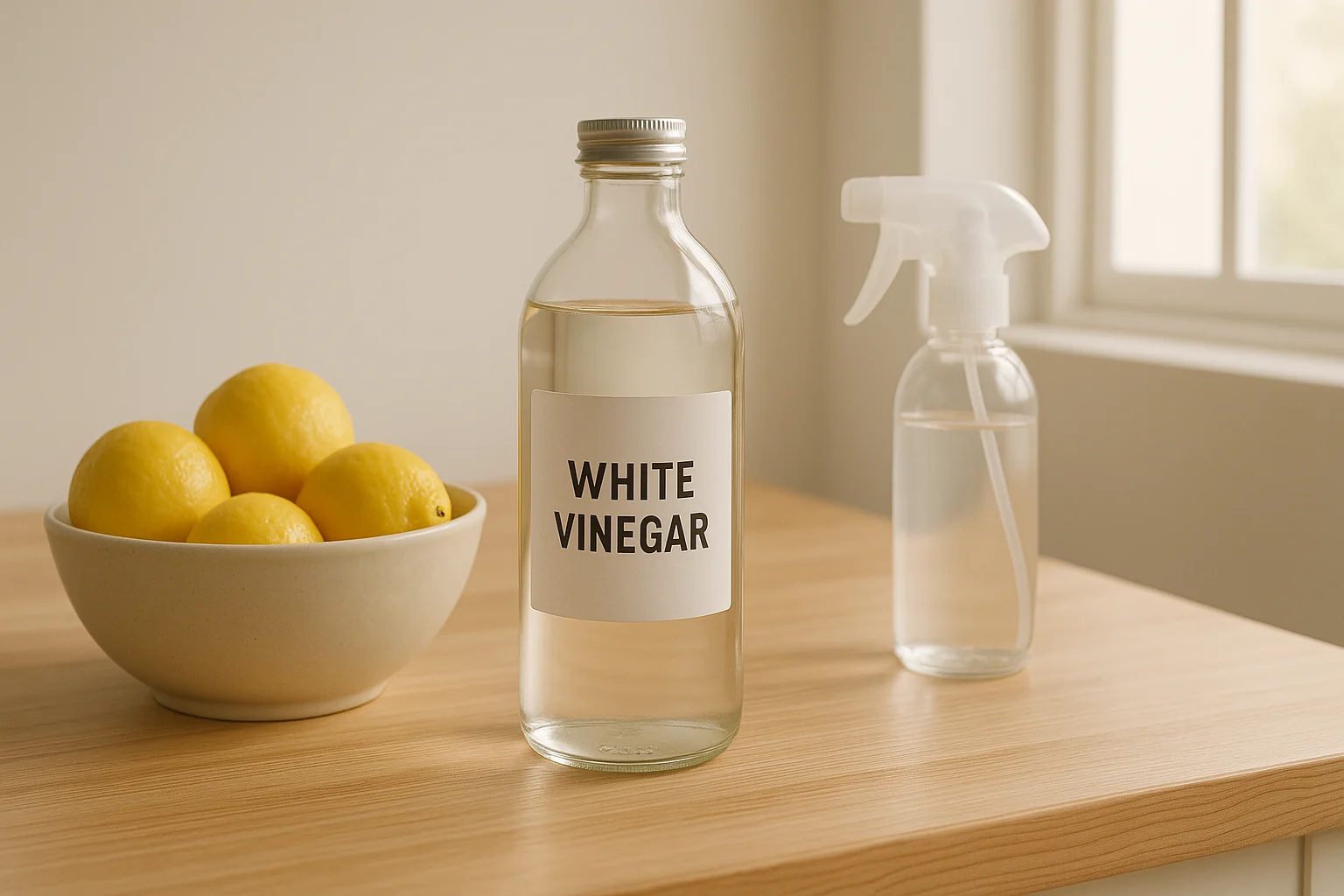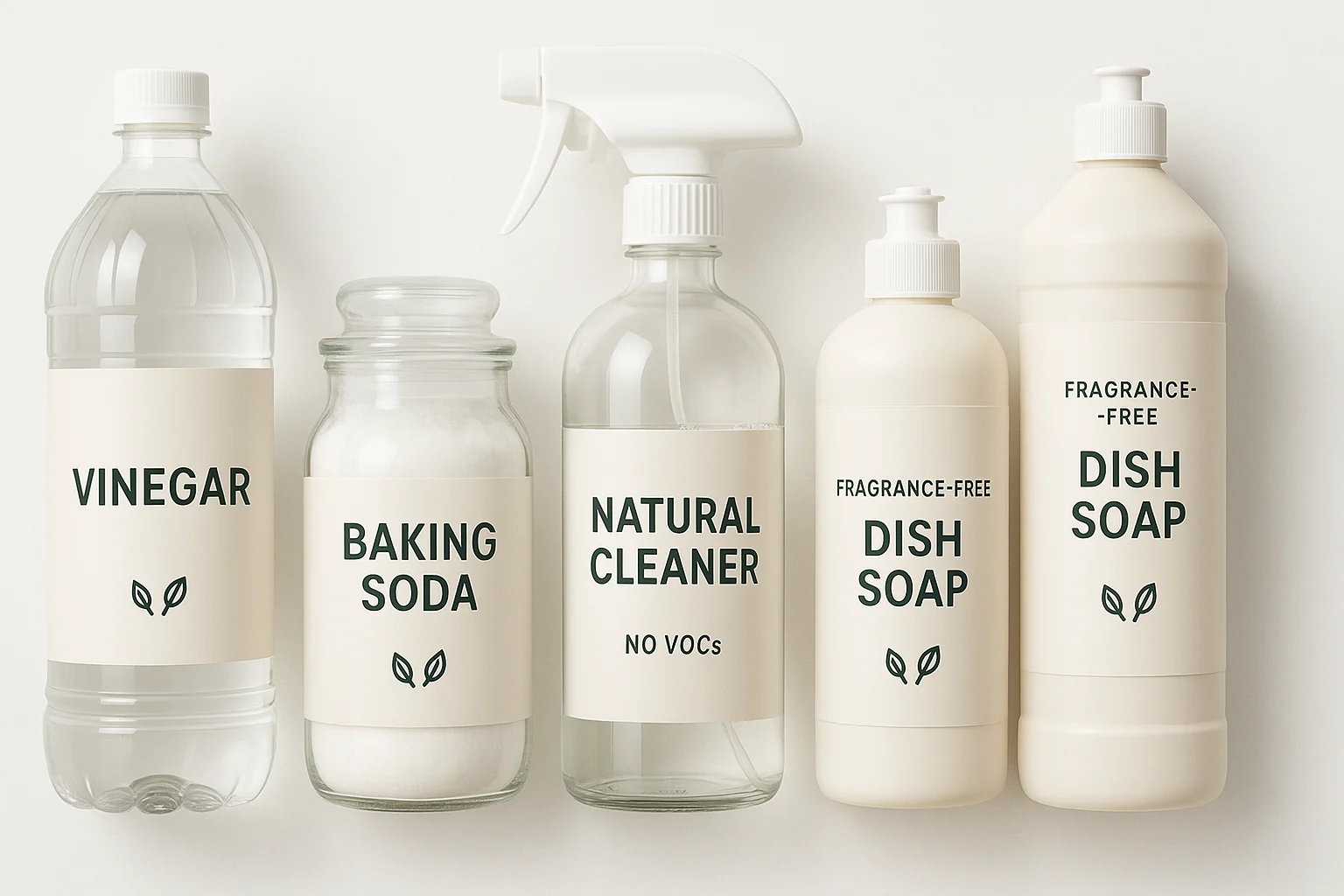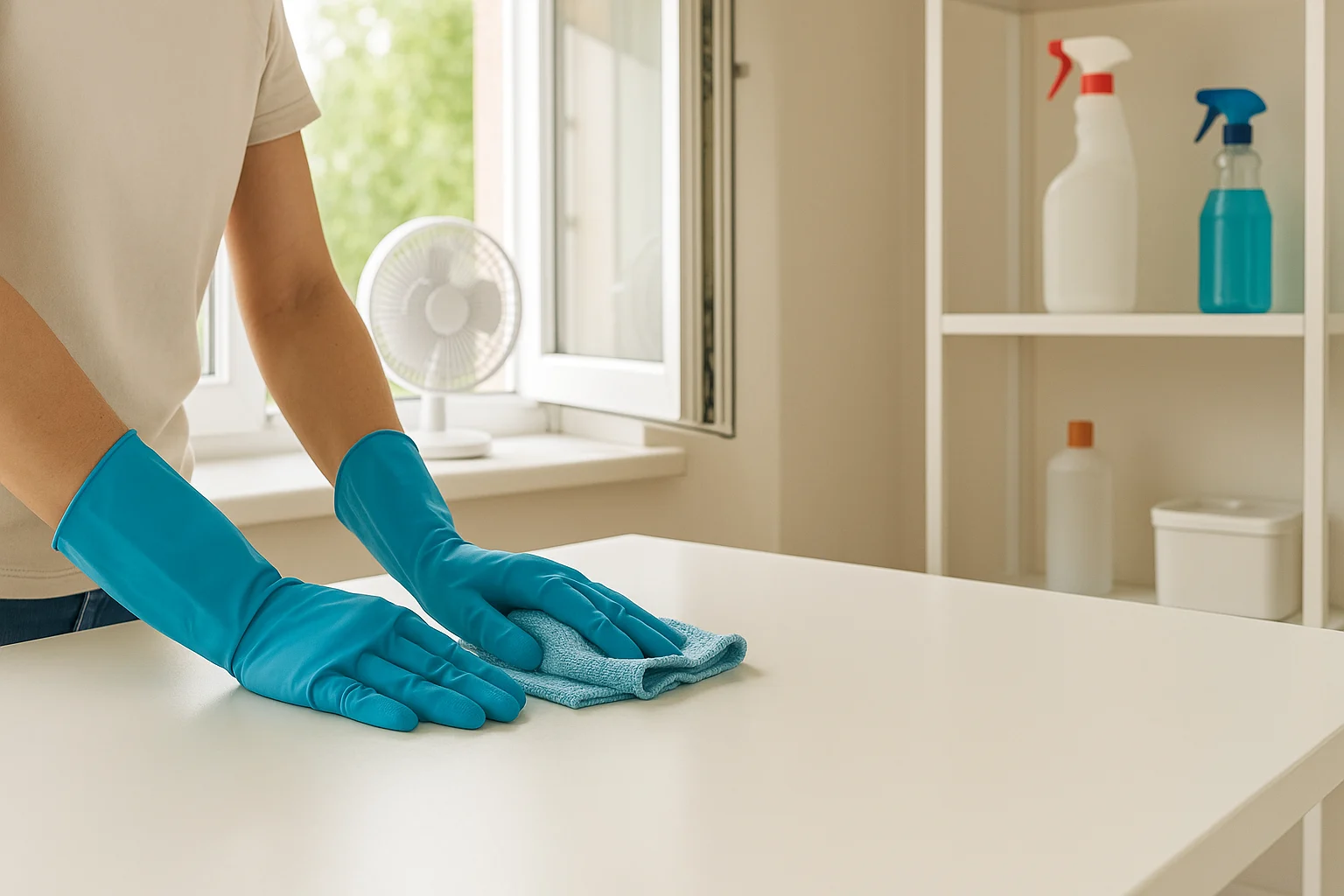
Cleaning day shouldn’t feel like picking a fight with your lungs. After years of wheezing through bleach fumes and “fresh linen” headaches, I rebuilt my kit with gentle, hard-working swaps—natural cleaning products for asthmatics that actually let me breathe. If strong smells tighten your chest, you’re not alone. This post draws on insights from our guide to the Homemade Cleaning Solutions Guide, including safe, effective strategies tailored for asthma.
But what if you could scrub away grime and still breathe freely? I’ve spent years testing options that are kind to sensitive airways yet tough on mess. Below are five non-toxic, asthma-safe cleaners that transformed my routine—no heavy perfumes, no harsh fumes, just a home that smells like… nothing.
Check Your Cleaners Now!Table of Contents
- Key Takeaways for Lung-Friendly Cleaning
- Why Traditional Cleaners Trigger Asthma
- My Journey to Asthma-Safe Cleaning
- Ingredient Checker for Asthma-Friendly Cleaners
- Top 5 Natural Cleaning Products for Asthmatics
- Asthma-Safe Cleaning Habits
- Frequently Asked Questions
- Final Thoughts: Breathe Easier
Key Takeaways for Asthma-Safe Cleaning
These quick wins set you up for asthma-safe cleaning—without harsh fumes.
- Traditional cleaners can flare symptoms: Many give off VOCs and heavy fragrances that can set off asthma. Simple, unscented options are usually easier on your lungs.
- Gentle alternatives can still clean well: You don’t need strong chemicals; simple ingredients like diluted vinegar (if tolerated) and baking soda clean effectively with fewer common triggers.
- Look for “fragrance-free” and short ingredient lists: These indicate products less likely to cause respiratory issues for asthmatics.
- Simple ingredients are powerful: Pantry staples are versatile and typically easier on sensitive airways.
- Switching improves indoor air quality: Safer choices benefit your lungs and create a healthier home.
Why Traditional Cleaners Trigger Asthma
Before exploring your options, let’s understand why traditional cleaners are problematic. It’s not just the strong smell; the real culprits are invisible gases and particles released into the air.
Volatile Organic Compounds (VOCs)
VOCs are gases released from certain liquids or solids that can irritate sensitive lungs. Common ones in cleaning products include:
- Formaldehyde: Found in some air fresheners and sprays.
- Limonene: Used for citrus scents; it can react with ozone to form formaldehyde.
- Phthalates: Used in artificial fragrances to prolong scents.
- Ammonia: Common in glass cleaners and floor waxes.
- Chlorine bleach: A disinfectant with irritating fumes.
When inhaled, VOCs may irritate airways, eyes, and skin. For asthmatics, this can mean inflammation or bronchoconstriction.
Artificial Fragrances vs Lung-Friendly Alternatives
“Fresh linen” or “mountain spring” scents can be complex mixtures that often include VOCs. Manufacturers may list them as “fragrance” or “perfume,” obscuring the full ingredient list.
Many artificial fragrances combine dozens—sometimes hundreds—of chemicals, some of which can irritate airways. For asthmatics, this can be a silent trigger.
Other Common Irritants
Beyond VOCs and fragrances, other ingredients cause issues: Ammonia can sting eyes, nose, and throat; Bleach (sodium hypochlorite) produces irritating fumes and is dangerous when mixed with ammonia or acids; and Quaternary Ammonium Compounds (quats) in some disinfectants and fabric softeners are associated with respiratory irritation. Use one product at a time and rinse between products.
This post contains affiliate links. If you buy through our links, we may earn a commission at no extra cost to you. Learn more.

My Journey to Asthma-Safe Cleaning
I used to dread cleaning with harsh chemicals—windows open, mask on—yet I’d still end up wheezing. A doctor flagged my products as a likely trigger, which pushed me to change. I ditched air fresheners first, then switched to “Free & Clear” detergents and simpler, low-odor cleaners.
There was trial and error, but I found a handful of products that clean without setting off my chest. My home now smells genuinely clean—like nothing at all. For budget-friendly ways to keep your home clean, explore these cost-saving cleaning tips.
Asthma-safe cleaners: ingredient checker
Please select an ingredient above to see safety guidance.
For disinfecting (e.g., after illness), use an EPA-registered product and follow label directions. Vinegar isn’t EPA-registered for disinfection. Never mix bleach with ammonia or acids like vinegar; ventilate well.
Top 5 Natural Cleaning Products for Asthmatics
Here are five lung-friendly cleaners that deliver a spotless home without compromising breathing.
| Product | Uses | Key Benefits | Where to Buy |
|---|---|---|---|
| Branch Basics Concentrate | All-purpose, glass, bathroom, laundry, hand soap | Fragrance-free, low-odor, hypoallergenic | Branch Basics website |
| White Vinegar | All-purpose, glass, descaler, toilet, laundry | Low-odor when dried; inexpensive | Grocery stores |
| Baking Soda | Scrubbing, deodorizing, drain freshener | Non-toxic, non-volatile, fragrance-free | Grocery stores, DIY floor cleaning recipe |
| Seventh Generation Free & Clear | Dish soap, laundry, dishwasher | Fragrance-free, plant-based, no dyes | Grocery stores, Seventh Generation at Target |
| Ecover Zero Toilet Cleaner | Toilet bowl cleaning | Fragrance-free, plant-based, biodegradable | Health stores, eco-friendly cleaning guide |

1. Branch Basics Concentrate: The Ultimate Multi-Tasker
If I had to choose one product, it’s Branch Basics—versatile and low-odor. This concentrate replaces nearly every cleaner under your sink.
What it is: A plant-based, fragrance-free concentrate diluted with water for multiple uses, including all-purpose, glass, bathroom, laundry, and hand soap.
Why it’s Asthma-Safe: It’s fragrance-free, low-odor, hypoallergenic, and avoids harsh ingredients like bleach or ammonia.
My Experience: It cuts through grease and leaves counters sparkling without any lingering scent. Laundry comes out fresh—not perfumed—which sensitive lungs tend to prefer.
Where to find it: Grab it on their website (Branch Basics).
2. White Vinegar: The Humble Powerhouse
White vinegar is a versatile, budget-friendly cleaner safe for many asthma sufferers (if you tolerate acetic vapors). For more DIY ideas, see our homemade upholstery cleaner.
What it is: It’s a dilute acetic acid solution with mild antimicrobial action—helpful for everyday cleaning—but it’s not an EPA-registered disinfectant.
Why it’s Asthma-Safe: Often tolerated when diluted, with low odor after drying compared to heavy perfumes.
My Experience: A vinegar-water spray leaves windows streak-free without the cough I got from older glass cleaners.
Where to find it: Any grocery store.
3. Baking Soda: Gentle Scrubber & Deodorizer
Baking soda is another staple for sensitive lungs.
What it is: Sodium bicarbonate—mildly abrasive and odor-absorbing.
Why it’s Asthma-Safe: Non-toxic, non-volatile, and fragrance-free.
My Experience: A baking soda paste cleans sinks and tubs without fumes. I also sprinkle it on carpets or in drains to freshen odors.
Where to find it: Grocery stores or our DIY floor cleaning recipe.
4. Seventh Generation Free & Clear: Everyday Essentials
Seventh Generation’s Free & Clear line is perfect when you want ready-to-use options.
What it is: Plant-based products without added fragrances or dyes, including dish soap, laundry, and dishwasher detergents.
Why it’s Asthma-Safe: Fragrance-free and dye-free with a low-odor profile.
My Experience: The dish soap cuts grease without throat irritation, and the laundry detergent leaves clothes scent-free.
Where to find it: Grocery stores, Target, or Seventh Generation at Target.
5. Ecover Zero Toilet Bowl Cleaner: Targeted Toughness
Ecover Zero offers a robust, fragrance-free toilet cleaner.
What it is: A plant-based cleaner from Ecover’s Zero line.
Why it’s Asthma-Safe: No added fragrance or dyes; biodegradable formula.
My Experience: It removes stains without the heavy pine fumes that used to make me cough.
Where to find it: Health food stores or our eco-friendly cleaning guide.

Asthma-Safe Cleaning Habits
Products matter, but your habits shape air quality just as much. Combine these practices with the products above to create a lung-friendly home. See our budget-friendly tips for families.
- Ventilate: Crack open windows and run exhaust fans to clear out dust and fumes.
- Choose Tools Wisely: Use microfiber cloths and a HEPA-filter vacuum to trap allergens.
- Dust Regularly: Use a damp cloth to trap dust.
- Avoid Aerosols: Opt for pump sprays to reduce airborne particles.
- Clean Top to Bottom: Start high, finish with floors to manage dust.
- Don’t Overdo It: Short, regular sessions beat harsh, infrequent marathons.
- Store Safely: Keep products sealed and out of reach.
Frequently Asked Questions
You’ll do best with unscented basics: diluted vinegar (if you tolerate it), baking soda, and “Free & Clear” detergents. Add a mild, plant-based concentrate for everyday jobs. Ventilate, spot-test first, and skip aerosols. Watch how your lungs respond and swap anything that causes irritation.
Fragrance-free, dye-free, and low-odor formulas are your safest bet. Microfiber cloths and a mild multi-surface concentrate cover most tasks. Use vinegar only if you tolerate acetic vapors; it’s not an EPA-registered disinfectant. HEPA vacuuming helps reduce dust and dander.
It can be for some. Vinegar releases acetic acid vapors that may irritate sensitive airways. If you tolerate it, dilute 1:1 with water, ventilate, and avoid enclosed spaces. If not, try unscented mild detergents or hydrogen-peroxide-based cleaners instead.
Ventilate, dust with microfiber, and vacuum using a HEPA filter. Choose fragrance-free cleaners and avoid aerosols and mixing chemicals. Clean top-to-bottom in shorter sessions to limit exposure, and store products tightly sealed to reduce lingering odors.
They’re hit-or-miss. Strong scents such as pine or citrus can irritate airways. If you try them, use tiny amounts, avoid small enclosed spaces, and stop if you notice coughing or tightness. Fragrance-free products are the lowest-risk choice.
Look for “fragrance-free” labeling and short, transparent ingredient lists. Avoid bleach, ammonia, and quats if they bother you. Test a small area first and use the ingredient checker on this page to flag higher-risk components before you buy.
Final Thoughts: Breathe Easier
Switching to natural cleaning products for asthmatics transformed my health. Every small change helped ease symptoms and made cleaning less stressful. I no longer dread cleaning day; instead, I feel empowered creating a safe, clean space.
A truly clean home smells like nothing—just fresh air. If you’re an asthmatic or care for someone who is, start with one product, monitor your response, and build from there. For deeper DIY options, explore our main resource: Homemade Cleaning Solutions Guide. Happy, healthy cleaning!
Medical & safety disclaimer: This article shares personal experience and general cleaning tips. It’s not medical advice. Always talk with your healthcare provider about asthma management and product choices. For disinfecting, follow public-health guidance and use EPA-registered products as directed. Never mix bleach with ammonia or acids (like vinegar). Ventilate well and stop using any product that bothers your breathing.